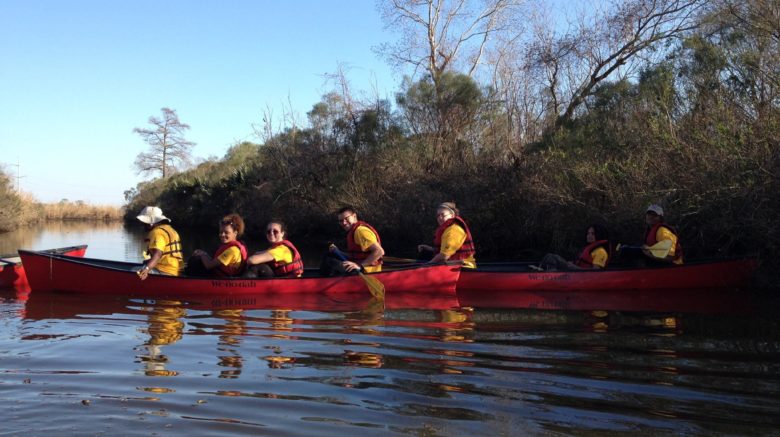Common Ground Relief works to proactively address the dangers faced by New Orleans and the Gulf Coast Region due to coastal land loss.
Our Vision
Common Ground Relief is working to create a future in which land is created and trees are planted faster than they are lost, where all residents have their needs for food and housing met regardless of economic or natural disasters; and all coastal life has the means to thrive together for generations to come.
Our Environmental Initiatives
Common Ground Relief was founded with the values of community care and stewardship, which means protecting and restoring Louisiana’s endangered coastline and training volunteers to do this work alongside our small team. We believe that hands-on engagement is essential for keeping people connected with the land and creating engaged and informed citizens who can protect and care for the land and water where they live.
To meet these goals, we grow native plants in our nursery in the Lower 9th Ward in New Orleans, host visiting volunteers at our volunteer housing as well and work with life-long New Orleanians to do marsh plantings in Southeastern Louisiana and gardening in our nursery. We also do environmental outreach and education in schools and around the state to spread awareness of our efforts and bring young people into the work of environmental protection.
Restoring Coastline Through Plantings
For over ten years, CGR has organized native tree and marsh grass plantings to rebuild land and habitat. In its 2023 planting season alone, CGR was able to plant 43,500 plugs of grass, restoring over 41 miles of linear shoreline. CGR is able to replant this incredible volume of native grasses with help from volunteers ranging in age from teens to retirees, who come out in the marshes and swamps to get their hands dirty in the name of coastal restoration. CGR has also used innovative landfilling techniques like working with repurposed Christmas trees and recycled glass to rebuild land lost through wetland degradation.
Central Wetlands Reforestation Collective
CGR is committed to planting 1,500 native trees and 2,000 plugs of marsh grasses each year for the next 4 years in the Central Wetlands Unit which spans 30,000 acres between Orleans and St. Bernard Parish. This work is done in partnership with the Central Wetlands Reforestation Collective (CWRC) which includes 5 organizations: CRCL, Pontchartrain Conservancy, The Meraux Foundation, CSED of the Lower 9th Ward, and ourselves. We are supported by the Louisiana Department of Agriculture and Forestry (LDAF), and we are funded by the Louisiana CPRA and NOAA Fisheries. The collective will plant over 60,000 trees and grasses by 2027. During this time we will be engaging with local residents, representatives, and visitors to our state as we advocate for the stewardship of this once-great freshwater cypress swamp. Once restored, we envision a future in which residents are protected from storm surges as they hunt, fish, and recreate in these waters. Sign up to volunteer with us to get involved!
Environmental Education
Hands-on learning is a core part of our programming, and in 2022 alone, CGR worked with over 400 students from over 20 high schools and universities and local green job training programs in projects at our nursery and at planting sites throughout Southeast Louisiana. CGR educators also travel to festivals, educational events and conferences to inform the public about our work in coastal restoration. Additionally, CGR leadership developed a classroom curriculum for high school students to develop environmental stewardship skills, in partnership with the Pontchartrain Institute Environmental Science at the University of New Orleans.

